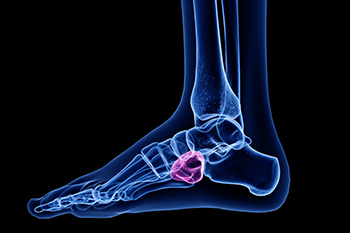
Cuboid syndrome involves lateral foot and ankle pain and is a disruption of the calcaneocuboid part of the midtarsal joint, which irritates the surrounding areas. The foot is made up of 26 bones, and the cuboid bone provides stability to the foot. This syndrome is thought to be from overuse, plantar flexion difficulties, and inversion ankle sprains. Athletes with foot injuries, particularly ballet dancers, can develop cuboid syndrome. Orthotics that are not constructed properly and heel spur surgery can also trigger the symptoms of this syndrome Because radiographic imaging does not detect this syndrome, it can be difficult to recognize, and can easily be misdiagnosed and mistreated. A diagnosis is based on history and symptoms. However, once properly diagnosed, it can respond well to conservative treatment that involves manipulation of the cuboid bone, exercises, and taping. If you have lateral foot and ankle pain that is persistent, it is suggested that you schedule an appointment with a podiatrist for a proper diagnosis and treatment.
Cuboid syndrome, also known as cuboid subluxation, occurs when the joints and ligaments near the cuboid bone in the foot become torn. If you have cuboid syndrome, consult with Dr. Steven Shlonsky from Louisville, Kentucky. Dr. Shlonsky will assess your condition and provide you with quality foot and ankle treatment.
Cuboid syndrome is a common cause of lateral foot pain, which is pain on the outside of the foot. The condition may happen suddenly due to an ankle sprain, or it may develop slowly overtime from repetitive tension through the bone and surrounding structures.
Causes
The most common causes of cuboid syndrome include:
- Injury – The most common cause of this ailment is an ankle sprain.
- Repetitive Strain – Tension placed through the peroneus longus muscle from repetitive activities such as jumping and running may cause excessive traction on the bone causing it to sublux.
- Altered Foot Biomechanics – Most people suffering from cuboid subluxation have flat feet.
Symptoms
A common symptom of cuboid syndrome is pain along the outside of the foot which can be felt in the ankle and toes. This pain may create walking difficulties and may cause those with the condition to walk with a limp.
Diagnosis
Diagnosis of cuboid syndrome is often difficult, and it is often misdiagnosed. X-rays, MRIs and CT scans often fail to properly show the cuboid subluxation. Although there isn’t a specific test used to diagnose cuboid syndrome, your podiatrist will usually check if pain is felt while pressing firmly on the cuboid bone of your foot.
Treatment
Just as the range of causes varies widely, so do treatments. Some more common treatments are ice therapy, rest, exercise, taping, and orthotics.
If you have any questions, please feel free to contact our office located in Louisville, KY . We offer the newest diagnostic and treatment technologies for all your foot care needs.












